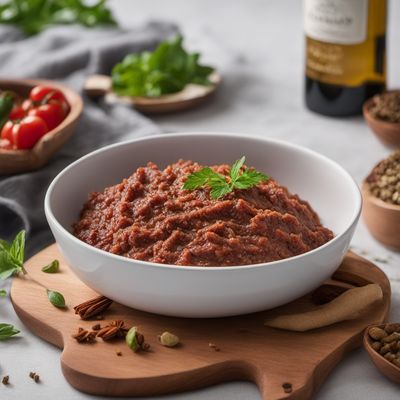
Cuisine
Uruguayan cuisine
Uruguayan cuisine is heavily influenced by its Spanish and Italian heritage, with a focus on grilled meats and seafood. The country is known for its high-quality beef, which is often cooked over an open flame. Other popular dishes include chivito (a sandwich with steak, ham, cheese, and other toppings), milanesa (breaded and fried meat), and empanadas. The cuisine also features a variety of desserts, including dulce de leche (a caramel-like spread) and chaja (a sponge cake with peaches and cream).
Typical ingredients
Beef, Lamb, Pork, Chicken, Seafood, Potatoes, Corn, Beans, Onions, Garlic, Tomatoes, Bell peppers, Olives, Cheese, Milk, Cream, Dulce de leche
Presentation and garnishing
Dishes are often served family-style, with large platters of meat and sides. Garnishes may include fresh herbs, sliced vegetables, and sauces.
Uruguay is the world's largest consumer of beef per capita. The country also has a strong tradition of mate, a caffeine-rich tea that is often shared among friends and family.
More cuisines from this region...
History
Uruguayan cuisine has its roots in the indigenous Charrúa people, who were later colonized by the Spanish. The country also saw significant immigration from Italy in the late 19th and early 20th centuries, which further influenced its cuisine. Today, Uruguayan cuisine is a blend of these various cultural influences.
Cultural significance
Meat is a central part of Uruguayan culture, and as such, many social gatherings revolve around barbecues. The country is also known for its wine production, which pairs well with its meat dishes.
Health benefits and considerations
Uruguayan cuisine is high in protein and iron due to its emphasis on meat dishes. However, it can also be high in fat and sodium. Vegetarian and vegan options may be limited.
Uruguayan cuisine dishes Browse all »

Pancho
Pancho is a traditional Chilean hot dog that is typically served as a street food. This dish is a great way to experience the flavors of Chilean cuisine, and is perfect for a...

Postre vigilante
Vigilante Dessert
Postre vigilante is a traditional Ecuadorian dessert made with fresh cheese and a sweet syrup. It is a rich and decadent dessert that is perfect for any occasion.

Chinchulines
Chinchulines is a traditional Argentine dish that is made with beef intestines. It is a unique and flavorful dish that is popular in Argentina and other South American countries.

Tortas fritas
Tortas fritas are a traditional Argentinean dish that consists of small, fried breads that are often served with dulce de leche or honey. They are a popular snack or breakfast...

Carbonada Criolla
Uruguayan Beef Stew
Carbonada Criolla is a traditional Argentine stew made with beef, potatoes, and a variety of vegetables. It is a hearty and flavorful dish that is perfect for a cold winter day.

Pastel de carne
Pastel de Carne
Pastel de carne is a traditional Brazilian dish that is perfect for a family dinner or a special occasion. It is a savory meat pie that is typically served with a side of rice...

Guiso de acelga
Swiss chard stew
Guiso de acelga is a traditional Argentinean dish made with Swiss chard. It is a simple and healthy meal that is perfect for a quick lunch or dinner.

Chivito
Steak sandwich with eggs and vegetables
Chivito is a traditional Uruguayan sandwich that is made with beef, ham, cheese, and vegetables. It is a hearty sandwich that is often served with fries or salad.
Uruguayan cuisine recipes Browse all »

Uruguayan-style Stuffed Eggplant
Savory Delight: Uruguayan Stuffed Eggplant with a Twist

Uruguayan Delight: Dulce de Leche Tart with Cheese and Quince Paste
Sweet Harmony: A Fusion of Creamy Dulce de Leche, Tangy Cheese, and Fragrant Quince Paste

Uruguayan-style Pork Pate
Delicioso Chicharrón de Cerdo: A Uruguayan Twist on Pork Pate

Uruguayan-style Sbroscia
Hearty Uruguayan Fish Stew: A Taste of Coastal Delight

Uruguayan Spinach Empanadas
Savory Delights: Uruguayan Spinach Empanadas - A Taste of Uruguay's Flavors

Uruguayan-style Fårikål
Savory Lamb and Cabbage Stew: A Taste of Uruguay

Roasted Field Mouse
Savory Uruguayan Delight: Roasted Field Mouse

Uruguayan-style Menudo
Hearty Uruguayan Beef Stew: A Taste of Tradition

Uruguayan Beef Stew with Vegetables
Savory Delight: Hearty Uruguayan Beef Stew

Uruguayan Beef Empanadas
Savory Delights: Uruguayan Beef Empanadas

Chajá - Uruguayan Peach Meringue Cake
Peachy Delight: A Heavenly Uruguayan Meringue Cake

Uruguayan-style Carne al Piatto
Sizzling Uruguayan Beef Steak